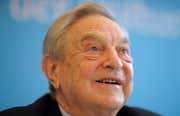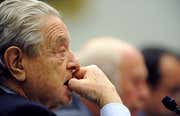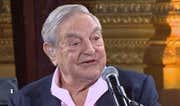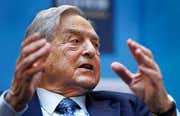
|
Soros' First Jobs
In 1954 Soros began work as a clerk at London-based merchant bank Singer & Friedlander, before eventually being promoted to the arbitrage department. While at the bank, one of Soros’ colleagues, Robert Mayer, recommended Soros for a position at his father’s brokerage house, F.M. Mayer.
(Related video: What is arbitrage?)
Accepting a position as an arbitrage trader at F.M. Mayer meant moving from London to New York, which Soros did in 1956. At the time, he specialized in European stocks when the creation of the Coal and Steel Community, later known as the Common Market, was making those stocks popular with U.S. investors. Having built a reputation in the field, he jumped to Wertheim & Co. in 1959 as an analyst of European securities.
Throughout his time at Werthem, Soros’ thoughts were elsewhere. His plan at the time was to keep working until he’d saved $500,000, which he deemed would be enough to allow him to go back to England to study philosophy in relative comfort.
Soros' theory of Reflexivity
During those years, Soros developed a theory he referred to as reflexivity. The idea grew from the philosophy of his former teacher at the London School of Economics, Karl Popper. Soros’ concept was that self-awareness is part of any given environment. That meant the act of creating a valuation in any market would necessarily be reflected in the actions of market participants, creating a virtuous or vicious cycle within the market. Likewise, any prediction could alter how financial actors behave to make a false statement become true, or vice versa.
Soros could see that the idea had applications beyond philosophy.
“It so happened that the concept of reflexivity provided me with a new way of looking at financial markets, a better way than the prevailing theory. This gave me an edge, first as a securities analyst and then as a hedge fund manager,” he would go on to write of the discovery.
Instead of going to London, he continued to work, moving to New York-based investment bank Arnhold and S. Bleichroeder in 1963. While at the firm, he rose to vice president, where his success persuaded the company to contribute $100,000 fund an investment vehicle for him to manage in 1966.
It would be the first big test of Soros’ philosophy, which he had developed to a state of bewildering complexity.
“I felt as if I were in possession of a major discovery that would enable me to fulfill my fantasy of becoming an important philosopher...as I delved deeper and deeper into the subject I got lost in the intricacies of my own constructions,” Soros would later write about his work on the theory. “At that point I decided to abandon my philosophical explorations and to focus on making money.”
Soros' First Fund
It worked. The next year, Arnhold and S. Bleichroeder allowed him to manage an offshore investment fund called First Eagle. Two years after that, capitalizing on the success of Soros’ first fund, the company created a second fund for him, called the Double Eagle hedge fund. It was the fund that would eventually grow into the Quantum Fund.
In 1969, the fund was seeded with $4 million of investor capital, which included $250,000 of Soros’ own money. The Rothschild family and other wealthy Europeans would go on to invest in the funds.
The success of both Eagle funds continued for several years, only to eventually be hindered by federal regulations concerning perceived conflicts of interest on Soros’ part. In response, he quit his position at Arnhold and S. Bleichroeder to create his own private investment company with the Double Eagle Fund.
He renamed the fund the Soros Fund in 1973, with $12 million in assets. George Soros co-managed the fund with Jim Rogers. Over the years, the two men would reinvest their returns from the fund, along with large portions of their annual 20% management fees.
They soon renamed their investment vehicle the Quantum Fund, after the principle of quantum mechanics discovered by physicist Werner Heisenberg. The fund began to deliver legendary returns. Not bound by many of the rules constraining mutual fund managers of the day, Soros had an ability and willingness to short the market during a period defined by crippling inflation and oil shortages. Between 1969 and 1980, the Quantum Fund had grown by a staggering 3,365% versus the 47% the S&P 500 posted.
By 1981 it had $400 million in assets, but that year it hit a stumbling block when it posted a 22% loss after a badly misplaced bet on interest rates. Investors ran for the exits, leaving it with just $200 million in assets. Soros took a year off to step back, handing over day-to-day management of the fund in the meantime. He used the period to examine world politics, monetary policies, and the other forces driving inflation, interest, and currency rates.
The fund did well in his absence, recovering the assets it had lost by the time Soros returned in 1984. Armed with the insights gleaned from his sabbatical, he immediately began making big bets. In 1985, the fund posted a 122% return and added $93 million to his personal fortune.
As the Quantum fund grew, so did his reputation as one of the top money managers in the world. In 1987, Soros took advantage of that reputation to publicize his philosophy. His book, titled "The Alchemy of Finance," described the intellectual underpinnings of Soros’ investment strategy.
By the late 1980s, Soros found his attention increasingly drawn to events in Eastern Europe. He again handed over day-to-day management of the fund in 1989, this time to his protégé Stanley Druckenmiller, who continued to deliver strong returns.
With strong returns and a stronger reputation, Soros Fund Management continued to grow. It reorganized in 1997 as a limited liability company in which Soros, Druckenmiller, and chief administrative officer Gary Gladstein shared control of the firm and the six funds it managed. The firm oversaw roughly $21.5 billion in assets by the middle of 1998.
That success on behalf of clients continued with a few hiccups until July 2011. That’s when Soros, concerned that new S.E.C. disclosure regulations would compromise his clients’ privacy, returned investor funds and invested $24.5 billion of his own money in the Quantum Fund. In 2013, the Quantum Fund, consisting of the Soros family fortune, garnered a return of $5.5 billion.
George Soros: Net Worth
-
 Investing
InvestingBy George: Investing The Soros Way
Soros turned an original seed funding of $12 million into $20 billion by the first decade of the 21st century. Can regular folks invest like George Soros? -
 Investing
InvestingWhere Does George Soros Keep His Money?
Learn about where George Soros keeps his massive fortune. Discover how Soros has supported various candidates and political causes during his career. -
 Insights
InsightsSoros's 13F Shows Continued Bearishness on Markets
George Soros has apparently decided that 86 is indeed too young to retire. -
 Investing
InvestingSoros Is Trading Again Amidst Global Concerns
Does Soros sense new opportunities on the horizon? -
 Financial Advisor
Financial AdvisorThis Is What George Soros' Portfolio Looks Like (SPY, YPF)
Learn about what George Soros is holding in his portfolio, including his large options position in the S&P 500 and what popular Internet stock he liquidated. -
 Insights
InsightsGeorge Soros 13F: Added Comcast, Increased Time Warner In Q3
The value of billionaire George Soros' portfolio fell during Q3. -
 Investing
InvestingSoros Eliminates Gold Stake in Q3 2016: 13F Filing
Billionaire George Soros made headlines earlier this year when he re-entered the gold market. Now recent regulatory filings indicate he is selling again. -
 Investing
InvestingWhy George Soros Tripled His Amazon Investment in Q3
According to a recent filing with the SEC, Soros more than tripled his investment in the company in just a few months.


